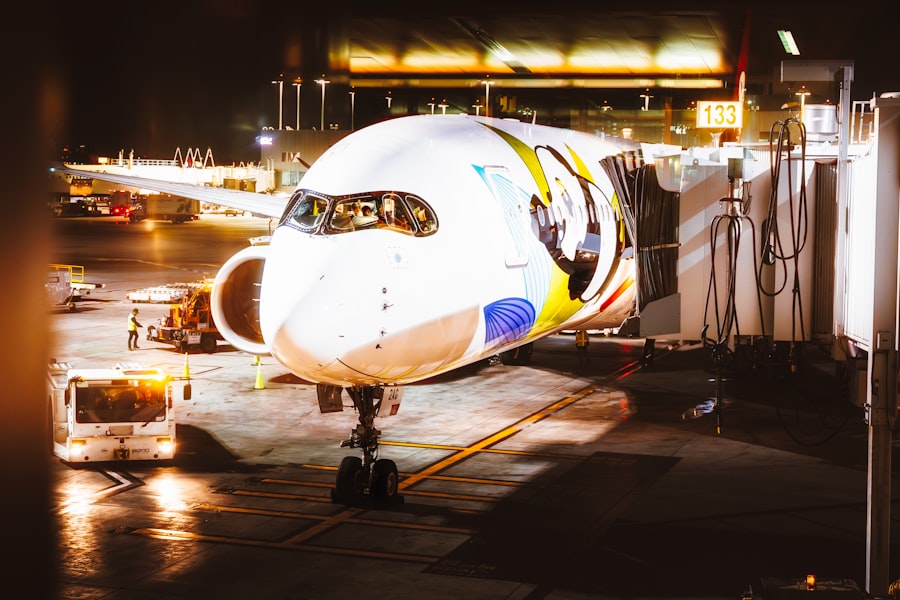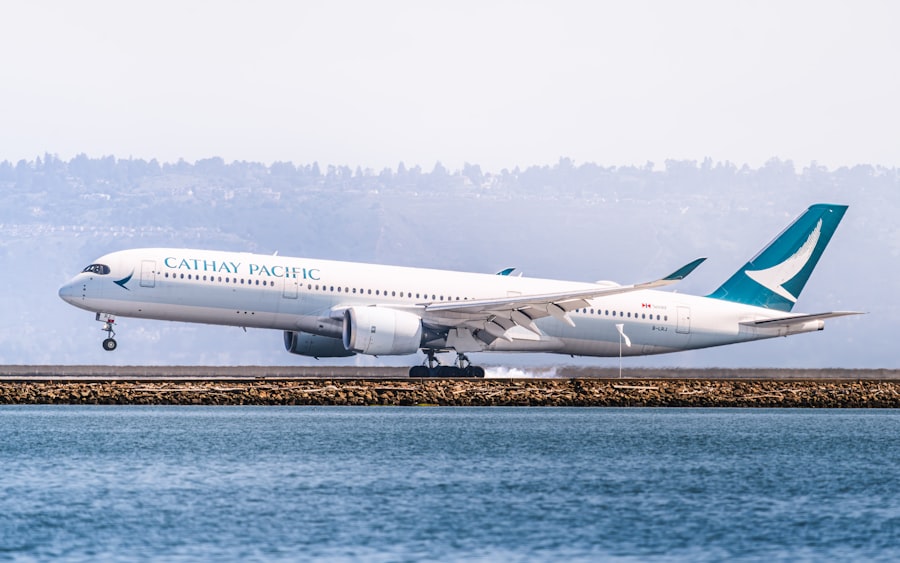The Airbus A350-900 is a remarkable addition to the modern aviation landscape, representing a significant leap forward in both technology and passenger experience. Launched in 2013, this aircraft is part of the A350 family, which was designed to meet the growing demand for long-haul travel while prioritizing fuel efficiency and environmental sustainability. The A350-900 variant is particularly notable for its ability to accommodate a wide range of routes, from transcontinental flights to intercontinental journeys, making it a versatile choice for airlines around the globe.
Airbus has positioned the A350-900 as a direct competitor to Boeing’s 787 Dreamliner, and it has quickly gained traction among major airlines. With its advanced materials, including a composite fuselage and wings, the A350-900 is not only lighter but also more durable than many of its predecessors. This aircraft has been designed with the future of air travel in mind, incorporating cutting-edge technology that enhances both operational efficiency and passenger comfort.
As airlines continue to seek ways to reduce their carbon footprint while providing an exceptional flying experience, the A350-900 stands out as a beacon of innovation in the aviation industry.
Key Takeaways
- The A350-900 is a popular long-haul aircraft known for its advanced technology and fuel efficiency.
- The A350-900 features a spacious and comfortable cabin design, with larger windows and better air quality for passengers.
- Passengers can enjoy a wide range of in-flight entertainment options and stay connected with onboard Wi-Fi.
- The A350-900 is known for its impressive performance and fuel efficiency, making it a popular choice for airlines.
- With advanced safety features and cutting-edge technology, the A350-900 is paving the way for the future of air travel.
Features and Design of the A350-900
The design of the A350-900 is a testament to modern engineering, characterized by its sleek lines and aerodynamic shape. The aircraft features a wingspan of approximately 64.75 meters, which is equipped with advanced wingtip devices known as winglets. These winglets play a crucial role in reducing drag and improving fuel efficiency, allowing the A350-900 to achieve impressive performance metrics.
The aircraft’s fuselage is constructed primarily from carbon-fiber-reinforced polymer, which not only reduces weight but also enhances resistance to corrosion and fatigue. In terms of capacity, the A350-900 can typically accommodate between 300 to 410 passengers, depending on the airline’s chosen configuration. This flexibility allows airlines to tailor their seating arrangements to meet specific market demands.
The cabin layout can vary significantly, with options for both two-class and three-class configurations. The spacious cabin design is complemented by larger windows that provide natural light and an enhanced sense of openness. Additionally, the cabin altitude is maintained at a lower level compared to traditional aircraft, which contributes to a more comfortable flying experience by reducing passenger fatigue.
Comfort and Cabin Experience

Passenger comfort is a cornerstone of the A350-900’s design philosophy. The cabin is designed with wider seats and more legroom than many other aircraft in its class, allowing travelers to stretch out during long-haul flights. The use of advanced materials in the cabin construction also contributes to a quieter environment, as the aircraft is engineered to minimize noise levels both inside and outside the cabin.
This focus on comfort extends to the lighting system, which utilizes LED technology to create a soothing ambiance that can be adjusted according to different phases of flight. Airlines operating the A350-900 have taken advantage of its spacious cabin by offering innovative seating options and amenities. For instance, some carriers have introduced lie-flat business class seats that provide a true sleeping experience for premium passengers.
In economy class, airlines have implemented features such as adjustable headrests and personal entertainment systems that enhance the overall travel experience. The combination of thoughtful design and passenger-centric features makes the A350-900 a preferred choice for travelers seeking comfort on long journeys.
In-Flight Entertainment and Connectivity
| Metrics | 2019 | 2020 | 2021 |
|---|---|---|---|
| Number of airlines offering IFEC | 215 | 198 | 185 |
| Percentage of aircraft with Wi-Fi | 39% | 45% | 52% |
| Passenger satisfaction rating | 7.5 | 7.8 | 8.2 |
In-flight entertainment (IFE) systems on the A350-900 are designed to keep passengers engaged throughout their journey. Many airlines have equipped their A350-900 fleets with state-of-the-art IFE systems that offer a wide selection of movies, television shows, music, and games. The high-definition screens are often larger than those found on older aircraft, providing an immersive viewing experience.
Furthermore, many airlines offer on-demand content, allowing passengers to choose what they want to watch at their convenience. Connectivity is another critical aspect of the A350-900’s appeal. With advancements in satellite technology and onboard Wi-Fi systems, passengers can stay connected while in the air.
Many airlines provide complimentary Wi-Fi access or affordable data packages that enable travelers to browse the internet, check emails, or engage with social media during their flight. This level of connectivity has become increasingly important for modern travelers who wish to remain productive or entertained while flying.
Performance and Efficiency
The performance capabilities of the A350-900 are impressive, particularly when considering its fuel efficiency. Powered by two Rolls-Royce Trent XWB engines, this aircraft boasts a range of approximately 8,000 nautical miles (about 15,000 kilometers), making it suitable for long-haul routes without the need for refueling stops. The Trent XWB engines are designed with advanced aerodynamics and materials that contribute to lower fuel consumption and reduced emissions compared to older engine models.
In terms of operational efficiency, the A350-900 has been engineered to optimize performance across various flight conditions. Its advanced flight control systems allow for smoother handling and improved fuel economy during takeoff and landing phases. Airlines operating this aircraft have reported significant savings in fuel costs, which not only benefits their bottom line but also aligns with global efforts to reduce aviation’s environmental impact.
The combination of range, efficiency, and performance makes the A350-900 an attractive option for airlines looking to modernize their fleets.
Safety and Technology

Safety is paramount in aviation, and the A350-900 incorporates numerous technological advancements that enhance its safety profile. The aircraft is equipped with an array of sophisticated avionics systems that provide pilots with real-time data on various flight parameters. These systems include advanced navigation aids and automated flight control features that assist pilots in maintaining optimal flight paths and managing potential hazards.
Moreover, the A350-900 has undergone rigorous testing and certification processes to ensure compliance with international safety standards. Its design includes redundant systems for critical components, ensuring that if one system fails, others can take over seamlessly. Additionally, the aircraft’s composite materials contribute to its structural integrity while reducing weight, further enhancing safety during flight operations.
The commitment to safety extends beyond design; airlines operating the A350-900 invest in comprehensive training programs for their flight crews to ensure they are well-prepared for any situation.
Routes and Destinations
Since its introduction into commercial service, the A350-900 has been deployed on a variety of routes across different continents. Major airlines such as Qatar Airways, Singapore Airlines, and Delta Air Lines have integrated this aircraft into their fleets, utilizing it for both high-demand domestic routes and long-haul international flights. For instance, Qatar Airways has famously used the A350-900 on routes connecting Doha with cities like New York and London, capitalizing on its range and passenger capacity.
The versatility of the A350-900 allows airlines to serve destinations that were previously challenging due to distance or capacity constraints. Its ability to operate efficiently on long routes means that airlines can connect secondary cities with major hubs without compromising on service quality or passenger comfort. As more airlines continue to adopt this aircraft type, it is likely that we will see an expansion of routes served by the A350-900, further enhancing global connectivity.
The Future of Air Travel
The Airbus A350-900 represents a significant advancement in air travel technology and passenger experience. As airlines increasingly prioritize sustainability and efficiency in their operations, this aircraft stands out as a model for future developments in aviation design. With its blend of comfort, performance, and cutting-edge technology, the A350-900 is not just a response to current market demands but also a glimpse into what air travel may look like in the years to come.
As we look ahead, it is clear that innovations like those found in the A350-900 will play a crucial role in shaping the future of air travel. With ongoing advancements in materials science, engine technology, and passenger amenities, future aircraft will likely continue to push boundaries in terms of efficiency and comfort. The A350-900 serves as a benchmark for these developments, illustrating how modern engineering can meet the needs of both airlines and travelers alike while addressing pressing environmental concerns within the aviation industry.


